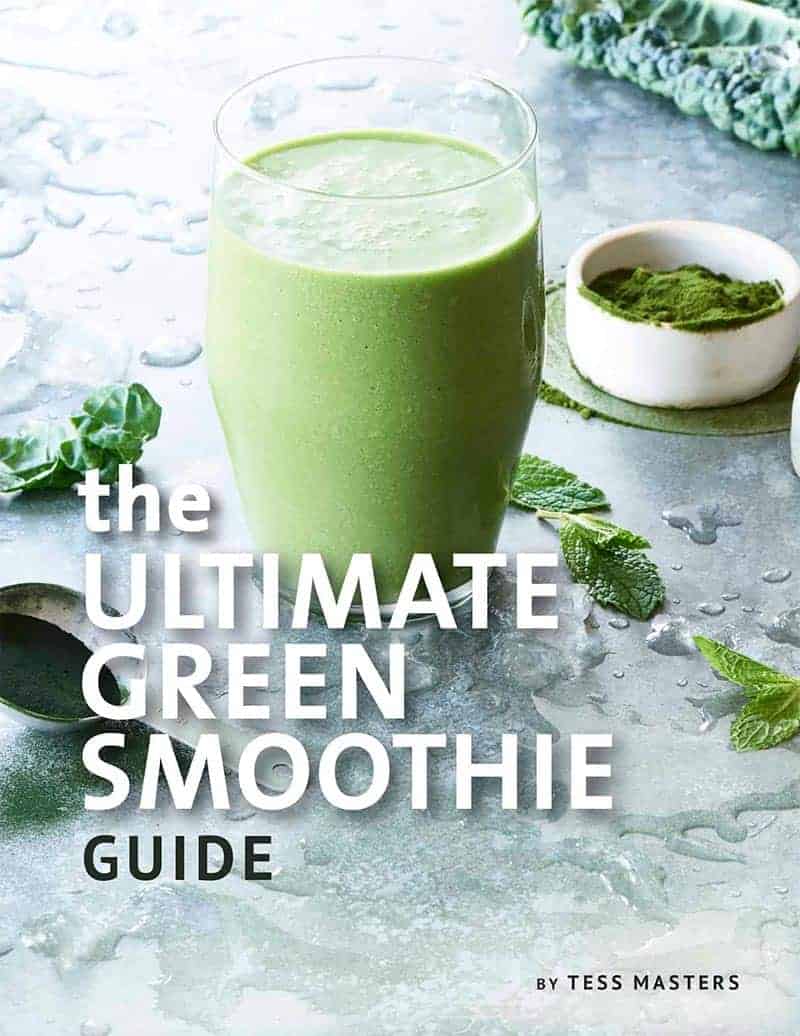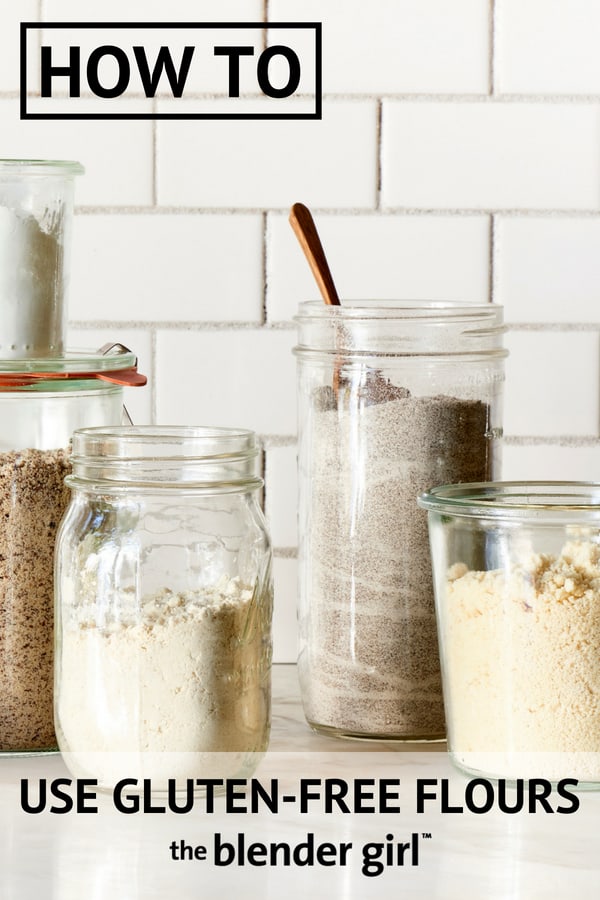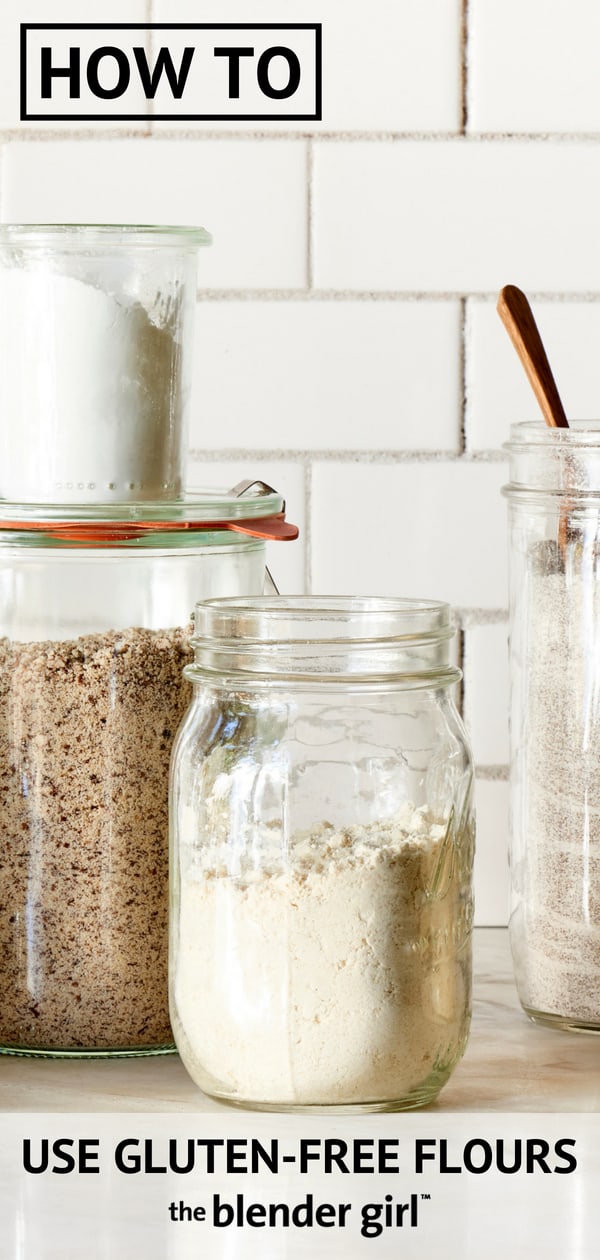Gluten-Free Flour
Tips for using all-purpose GF flour and flour made from rice, almond, coconut, oats, buckwheat, and more to make recipes.
A Guide To Gluten-Free Flour
There are a variety of gluten-free flours that can yield fantastic results in gluten-free recipes.
It can be challenging to achieve the right structure, texture, kneadability and rise that comes so easily with wheat gluten. However gluten-free flours can offer more nutrient density than traditional wheat flour.
Becoming familiar with the character of each gluten-free flour and learning how to combine protein-rich and starchy flours for the best textures takes some knowledge and practice.
Commercial all-purpose gluten-free flour mixes have made gluten-free baking much easier. Most proprietary mixes are similar in composition, relying heavily on rice flour, potato starch, cornflour, and tapioca.
If you prefer more interesting, nutrient-dense flours experiment with creating your own flour blends.
Combining fibrous and starchy flours, and adding baking powder, baking soda, and xanthan or guar gum yields good results with gluten-free vegan baked goods. Binding can also be an issue with gluten-free vegan baking.
Typically gluten-free flours absorb a lot more moisture than wheat flour, so a bit more liquid might also be needed.
You'll also need to experiment with egg substitutes such as banana, applesauce, mashed pumpkin, chia and flax eggs, aquafaba, and egg replacers.
Table of Contents
- A Guide To Gluten-Free Flour
- Flours that are gluten-free
- How to store gluten-free flours
- All-Purpose Gluten-Free Flour
- Buckwheat Flour
- Sorghum Flour
- Almond Flour and Almond Meal
- Coconut Flour
- Hazelnut Meal
- Chestnut Flour
- Chickpea Flour and Besan
- Soy Flour
- Rice Flour
- Oat Flour
- Millet Flour
- Quinoa Flour
- Amaranth Flour
- Tapioca Flour
- Arrowroot
- Kuzu
- Potato Flour and Starch
- Corn Flour and Starch
- Baby Rice Cereal
- Baking Powder
- Baking Soda
- Cream of Tartar
- Xanthan Gum
- Guar Gum
- Yeast
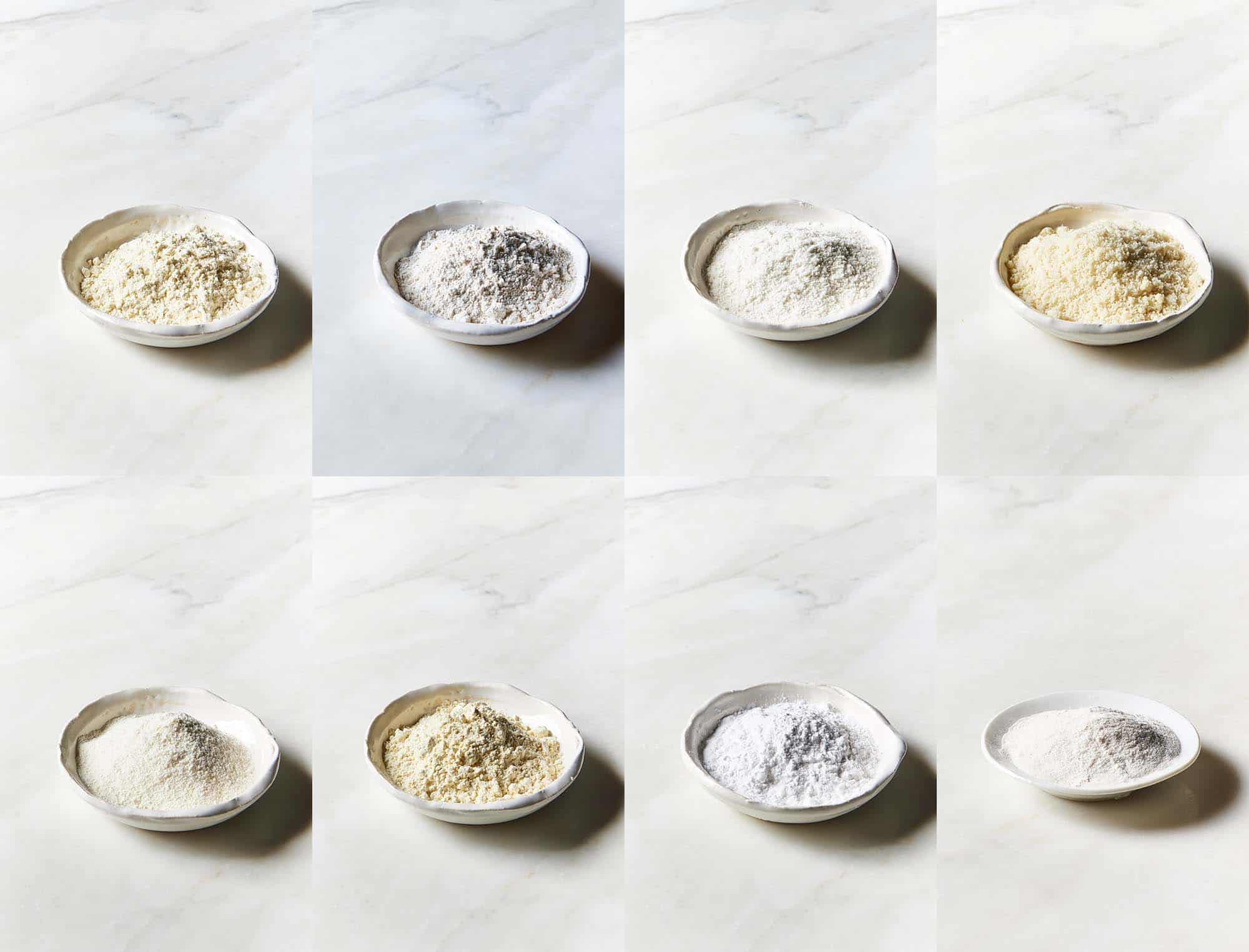
Gluten-Free Flours
There are a lot of flours that are gluten-free.
- all-purpose gluten-free flour blends
- almond flour or almond meal
- coconut flour
- buckwheat flour
- rice flour
- oat flour
- potato flour or starch
- cornflour
- arrowroot
- tapioca flour or starch
- sorghum flour
- chickpea flour or besan
- fava bean flour
- garbanzo and fava flour
- amaranth flour
- hazelnut meal
- millet flour
- quinoa flour
- soy flour
- chestnut flour
How to store gluten-free flours
The best way to store your gluten-free flour is in sealed glass jars in the fridge or a dark cool pantry to prolong the shelf-life and preserve the delicate oils that can be prone to rancidity.
Some gluten-free need to be used within a few months after opening.
If freezing gluten-free flours, store in air-tight containers that do not allow any moisture in, and fully defrost and bring the flour to room temperature before using or you may have some consistency issues with your finished product.
Purchase flours that are as fresh as possible from retailers with a high turn over.
A better option is to grind flour from the raw ingredient and use the flour immediately.
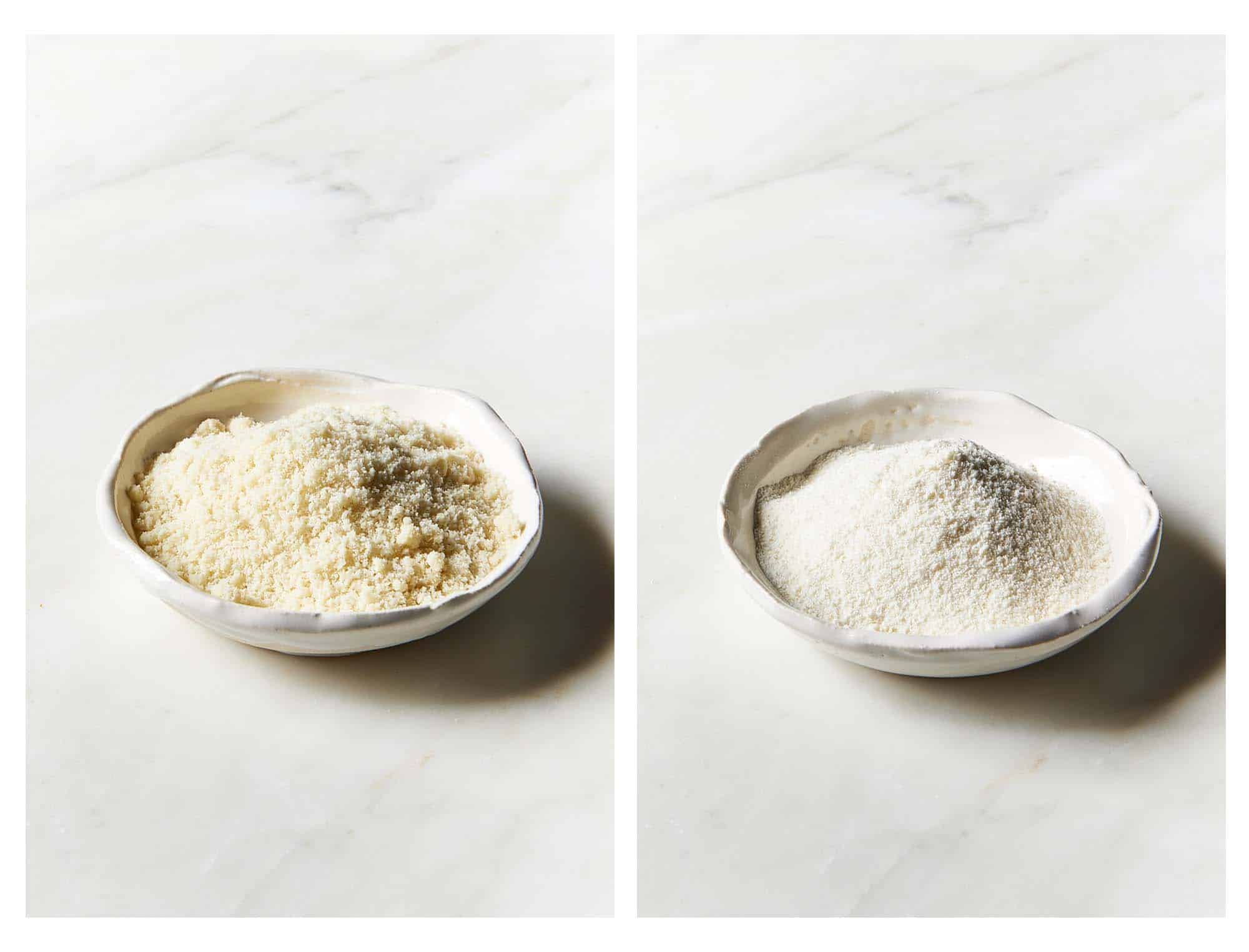
All-Purpose Gluten-Free Flour Blends
There are a wide variety of gluten-free flour mixes available.
Most blends are a mixture of rice flour, potato flour or potato starch, corn starch, and tapioca flour.
However, there are some more exotic mixes available that include more nutrient-dense flours like buckwheat, quinoa, and amaranth flour mixes.
Store these flours in sealed glass jars in the fridge.
Buckwheat Flour
Buckwheat flour comes in light, medium and dark varieties. Dark buckwheat flour contains some of the hull, and has a robust earthy flavor. This is wonderful for enriching pancake and crepe batters. Whereas the light flour is milder and more neutral, and is more suitable for using in gluten free flour mixes for cakes, muffins, cookies, biscuits and breads. Buckwheat flour can be used to thicken sauces and stews. But I prefer to use arrowroot.
Buckwheat is a nutritionally dense, gluten free alternative to white starchy flours. It is high in fibre, protein (containing all 8 essential amino acids), Vitamin B, magnesium and manganese, just to name a few.
It has a greyish color, a strong flavor, and a gritty texture. I usually mix it with other flours and use buckwheat flour for ¼ or 1/3 of my baking mix. This tends to yield the best results in cakes, breads, and muffins. Straight buckwheat tends to yield a product with a bitter after taste.
Always purchase buckwheat flours from a store with a high product turn over to ensure maximum freshness. Be careful that there is no moisture, and the flour has been stored in the fridge. Buckwheat flour will only keep for a few months and then it will go rancid.
For those of you with food allergies, buckwheat is often mixed with wheat or processed in facilities that handle wheat. Please be sure to purchase 100% buckwheat with a gluten-free accreditation.
I tend to use buckwheat flour for savory baked goods. It is fantastic for making Indian Pakoras. You can easily make buckwheat flour by grinding buckwheat groats in your food processor, the grain mill attachment on your stand mixer, or in the dry carriage of your blender.
Sorghum Flour
Sorghum flour is pronounced “sor-gum” is ground from the sorghum grain, which is similar to millet. Sorghum is a staple in Africa and India and one of the top five cereal crops in the world. Sorghum flour is typically used to make flat unleavened breads and a porridge-like meal.
This gluten-free flour is bit harder to source than the other flours. You can find it at some health food stores or look for it at specialty stores or Indian grocers. It is also known as “jowar” or “juwar”.
Sorghum flour is a high-fiber flour that is also rich in iron and protein. Sorghum flour has a creamy white or yellow tint, with a fairly neutral flavor, that is slightly sweet. But if you use too much in baked goods it can yield a product with a slightly bitter aftertaste and dry, crumbly texture. It fairs best when combined with other starchy flours such as potato and rice flour, and makes beautiful rich gluten-free bread when combined with bean flours such as fava or chickpea flour.
When working with sorghum flour, add ½ teaspoon of corn starch for every cup of sorghum flour; ¼ more baking powder or baking soda; and add in a little more liquid (about 1/ more) or an extra egg for added moisture and leavening in baked goods like muffins. For breads, add one whole teaspoon of cornstarch and the same amount of liquid.
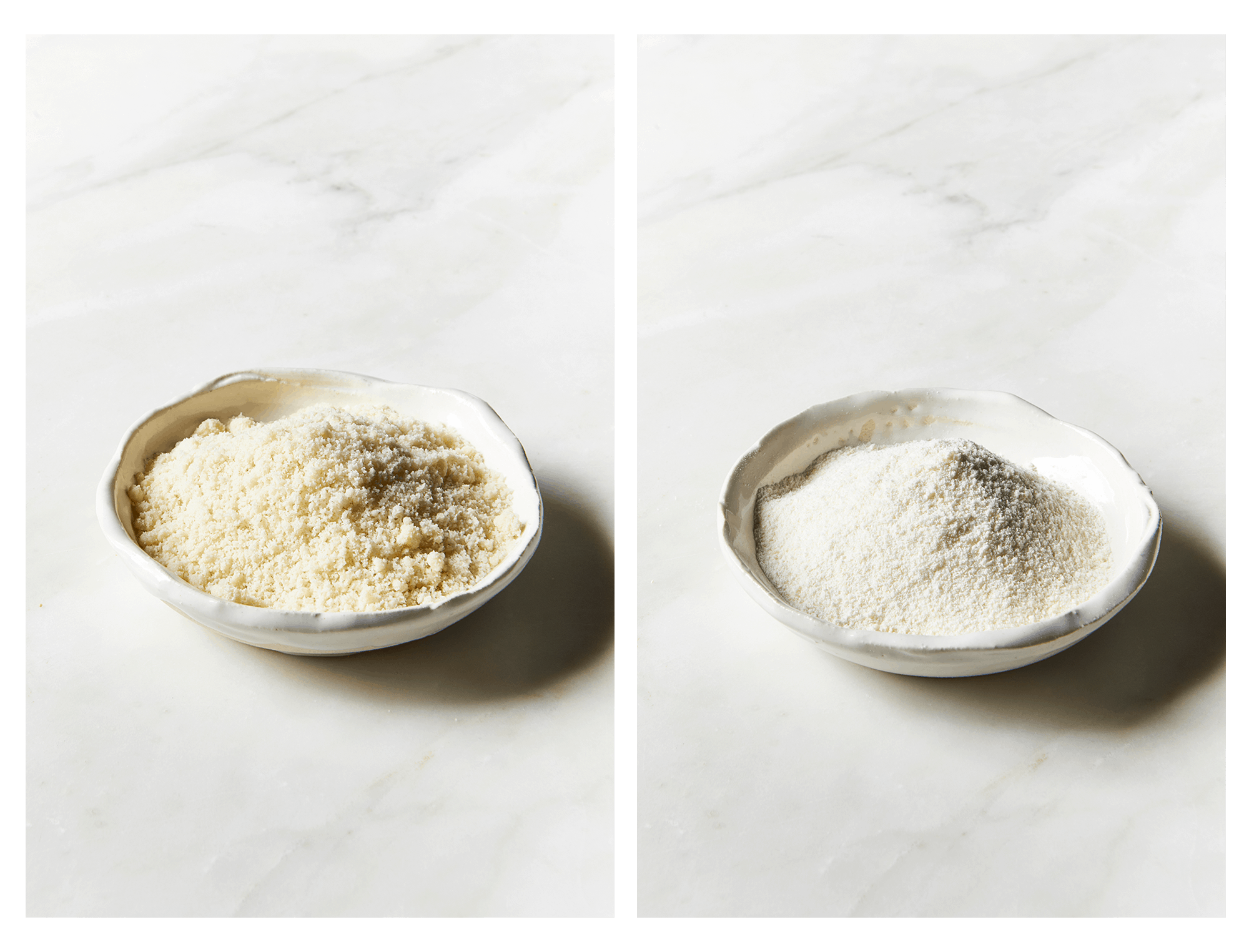
Almond Flour and Almond Meal
Almond Flour
Almond flour comes in two varieties: regular and blanched. Blanched almond flour is the kind I use.
Blanched almond flour is a nutrient-rich gluten-free flour that has a low glycemic index perfect for adding moistness to baked goods.
The beauty of this flour unlike so many other gluten free flours is that it bakes up splendidly on its own, and does not need to be combined with other flours.
Note that when using almond flour you will usually need to add in more eggs or egg substitute in order to provide a bit more structure.
Blanched almond flour works best in sweet “quick bread” type recipes such as muffins, cakes, and pancakes. I don’t find it suitable for more traditional breads as you can’t really get a dough-like consistency.
Blanched almond flour can be frozen for up to six months to assist with preservation. But it must be fully defrosted and brought to room temperature before use or you will have some consistency issues.
This flour is one of the really pricy ones! Order online in bulk and freeze to save on costs.
Almond Meal
Unlike blanched almond flour which is extremely fine, almond meal is made by grinding whole or blanched almonds, and has a grittier texture than wheat flour that is similar to cornmeal. Almond meal is often one of the principle ingredients (along with hazelnut meal) in flourless cakes and other gluten free baked goods. It also makes delicious marzipan and almond paste.
Almond meal is low on the glycemic index, and adds a gorgeous nutty flavour that just seems to work with most combinations! If you want to heighten the almond flavour, add a splash of almond essence.
With almond meal you will generally need to add in more eggs in order to give the batter a bit more structure for leavening. It will also yield a slightly denser finished product. Because almond meal is just ground whole almonds, it has the same nutritional profile, being high in protein and Vitamin E, as well as manganese and potassium.
Purchase almond meal in bulk online and freeze for greater preservation. Or purchase from a health food store with a high turn over to ensure maximum freshness. Store in a sealed glass container in the fridge or freezer. Alternatively, some gourmet coffee stores have dedicated grinders, and will grind up fresh almond, chestnut or hazelnut meal on request.
You can make your own almond meal by using your food processor or your high speed blender. I use the dry carriage of my blender. If you're grinding in the blender, just make sure to use the pulse setting just a few times, or you will quickly blend up raw almond butter!
Coconut Flour
Made from the ground meat of organic coconuts coconut flour has a really high fiber content; a low amount of digestible carbohydrates; and is a decent source of protein.
The indigestible carbohydrates in coconut flour (carbohydrates that are mainly composed of fibre and are not absorbed by the body) are actually beneficial to health.
Like all natural coconut products, the indigestible carbohydrate in the form of fibre in coconut flour has extraordinary health benefits -- from aiding digestion, to regulating blood sugar levels, to preventing heart disease and cancer.
There are two ways of making coconut flour. The “fresh-dry” process, where the coconut oil is extracted from the grated dried coconut meat, which produces a product with an approximate fiber content of 40%; and the “wet” processing method, where the coconut milk is extracted from wet grated coconut meat, and then dried, resulting in a product with less fat and protein, which yields a product of about 60% fiber content.
I prefer the dry process, which produces a coconut flour with a more balanced nutritional profile. You can use either. But just note that quantities in some recipes might need to be tweaked to allow for the slightly different personalities of these flours.
Coconut flour can lower the glycemic index of other foods when combined in recipes. So it makes a fantastic low-carb, high-fibre substitute in sweet baked goods for diabetics or people watching their sugar intake.
Coconut flour has a similar consistency to wheat flour, but does not work with a straight 1:1 substitution in conventional recipes. For substituting, it works much better as about ¼ of a gluten free flour mix.
You can use coconut flour on its own to bake up delicious gluten free baked goods. But you need a lot of eggs to make coconut flour replicate more traditional flours. I have found, as a general rule, that you need about 3 eggs per ½ cup of coconut flour. I have not used egg replacers with dedicated coconut flour recipes, (seeing as you need to use a lot of eggs. I don’t see the point).
Coconut flour is highly absorbent and lighter than almond flour, so other ingredient ratios are different as well. I have found that if you add ½ cup of coconut oil, grape seed oil, butter or apple sauce to every ½ cup of coconut flour, you can achieve a decent balance.
The good news is that you don’t need to add milks. Just add in your flavorings such as chocolate, carrots or fruit, and your sweetener (about ½ cup). For leavening, try adding 1/2 tsp of Celtic sea salt and 1/2 tsp baking soda for every ½ cup coconut flour, and you should have a decent start.
Some recipes benefit from a bit more of a coconut boost. So you could add in ½ cup of shredded coconut. You will bake most coconut goods at a slightly higher temperature than normal at about 180 C/350 to 200 C 400 F.
Hazelnut Meal
Made by grinding natural or roasted hazelnuts, hazelnut meal is one of the principle ingredients found in a lot of flourless chocolate cakes.
Because hazelnut meal is just ground whole hazelnuts it has the same nutritional profile as whole hazelnuts.
Hazelnuts and hazelnut oil are great sources of Vitamin E which can protect against heart disease and cancer.
Yeah...I remind myself of this as I'm grabbing for that second or third piece of chocolate cake!
You can make your own hazelnut meal by roasting hazelnuts, removing the skins, and grinding them in your food processor or dry carriage of your high-speed blender. If using your blender, use the pulse setting and gradually pulse or you may get hazelnut butter.
Chestnut Flour
Made from ground chestnuts, this delicious gluten-free flour is typically used in Italian desserts. Like other nut flours, it can be ground to a variety of consistencies. Typically, you will find chestnut flour that is stone ground (course) or fine.
Chestnut flour has a mild, slightly sweet flavor and a greyish tan tint that blends beautifully with chocolate, hazelnuts, almonds and coffee; and as fabulous as they are, makes an interesting departure from the ubiquitous almond and hazelnut meals that dominate in flourless cakes.
Having said that, it is a lot more versatile, working really well in combination with starchy flours like white rice, potato, corn and tapioca flour.
Chestnut flour makes a wonderful addition to baked goods. Chestnut flour, in contrast to other nut meals, contains very little fat and oil, and is cholesterol free.
Because chestnuts are high in complex carbohydrates, they have a low glycemic index, making them an even better addition to sweet treats. And even though they are relatively low in protein; it is good quality protein, similar to that found in eggs, and is easily assimilated by the body.
Purchase chestnut meal from a health food store with a high turn over to ensure maximum freshness.
Alternatively, some gourmet coffee stores have dedicated grinders, and will grind up fresh chestnut, almond or hazelnut meal on request. There is nothing better!
For some fantastic recipes utilizing chestnuts, head to Chestnuts Online. Please note, that when using chestnut flour, you will usually need to add more eggs to provide a bit more structure to leaven and bind gluten free goods.
Don’t confuse this flour with water-chestnut flour, which is a powdery starch that is typically used as a substitute for cornstarch to thicken Asian recipes or to coat fried foods.
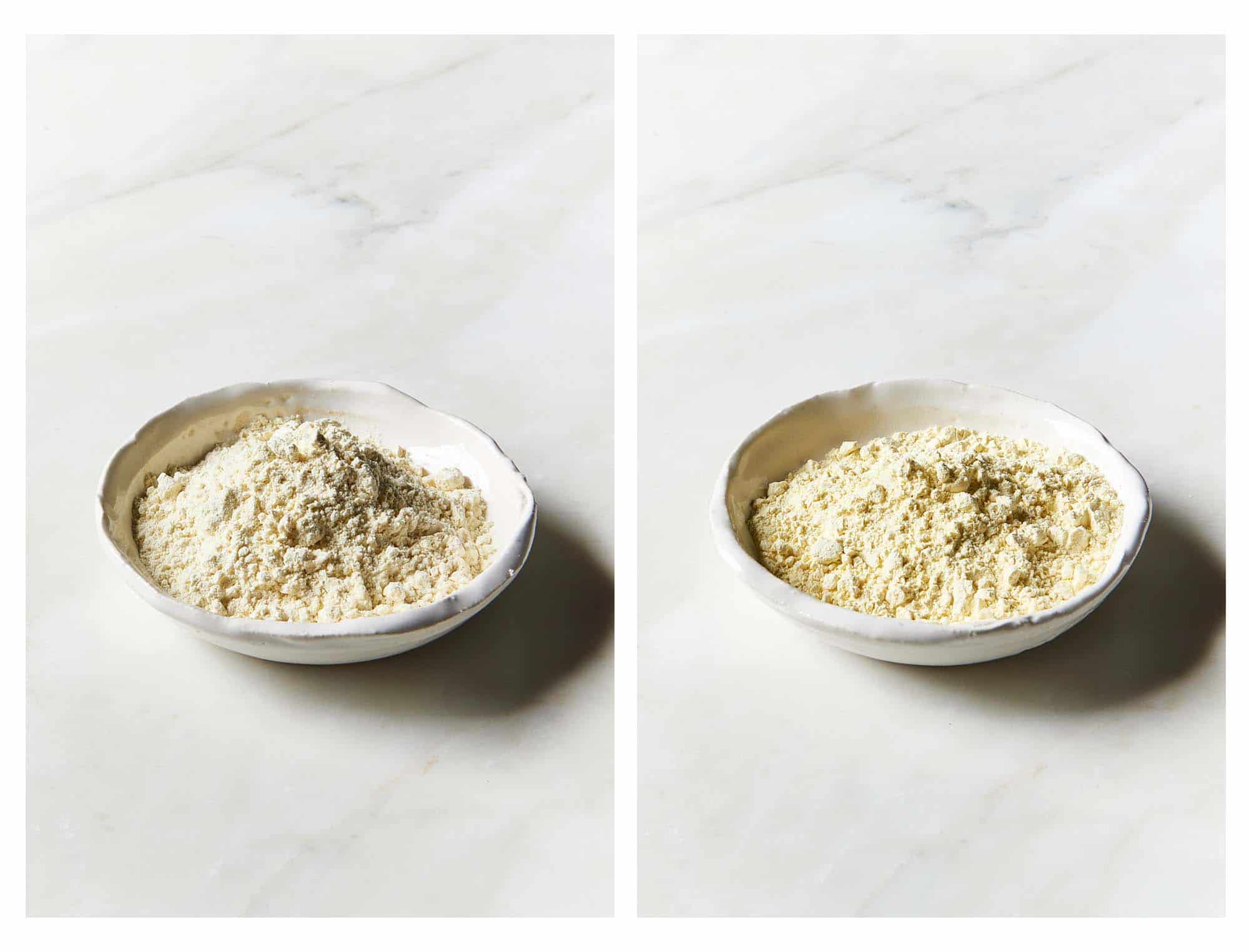
Chickpea Flour and Besan
There are two types of chickpea flour.
Chickpea flour or garbanzo bean flour is made from crushing chickpeas. This variety is mainly used in parts of Italy, France and the Mediterranean; and this is the variety that is widely available in health food stores due to its versatility and delicious nutty flavor. You can find the Indian variety, which is great for batters, at Asian grocers and specialty stores.
Chickpea flour is high in carbohydrates and proteins, and has more fiber and folate than wheat flour. It has a strong flavor and distinct golden appearance. Always purchase chickpea flour made from cooked chickpeas, which are easier to digest and don’t cause as much flatulence. Purchase from a health food store with a high turn over, and store in a sealed glass container in the fridge.
This flour is versatile, but has an extremely rich, distinct flavor, so is best used in combination with other flours in pasta and pizza doughs; as well as part of a gluten-free flour mix for baked goods. You can use it on its own in wonderful savory flat breads like socca, as well as other crusts and bases.
For a quick savory gluten free crust: just put one cup of chickpea flour in a food processor with a little bit of Celtic sea salt, and drizzle just enough olive oil to get the consistency of bread crumbs. Knead this gluten free dough, press into a quiche dish, and add your favorite toppings.
Indian-style chickpea flour that is primarily used in India, Pakistan and Bangladesh is actually not made from chickpeas at all, but rather, chana dal, a cousin of the chickpea. It is sometimes referred to as gram flour, dal flour, pea flour, or besan.
The Indians make a natural face mask or scrub out of besan. Mix the flour with some raw honey, rose water or olive oil, and make a paste. Leave on for about 15 minutes and then gently rub off. It is phenomenal.
Soy Flour
This protein-rich gluten-free flour has a yellowish color and strong nutty flavor that is made by grinding soy beans.
Soy flour is rich in calcium, iron and Vitamin B. It is typically available in two varieties – natural and defatted.
Natural soy flour contains all of the fats and oils of the original bean. Whereas, defatted soy flour has had the oils removed, yielding a product with a highly concentrated protein content. But both varieties give a protein boost and add moisture and a nutty flavor to gluten free baked goods.
However, if you use soy flour on its own it is incredibly pungent and overpowering. I find it is best used in combination with starchy flours such as rice and potato flour.
Don’t be alarmed if you taste the batter and it is really bitter and smelly. That cooks away, and the final product is delicious. But too much soy flour will yield a bitter product that is not particularly palatable. You will also need to adjust the oven temperature or shorten the baking time in order to avoid over-browning and burning.
Soy flour has a high fat content, and so is subject to rancidity. Always purchase from a health food store with a high turn over, store in a sealed glass container in the fridge, and use in good time.
Soy flour can be used as an egg substitute to add moisture to allergy free recipes. Just use 1 tablespoon of soy flour and 1 tablespoon of filtered water for every standard egg.
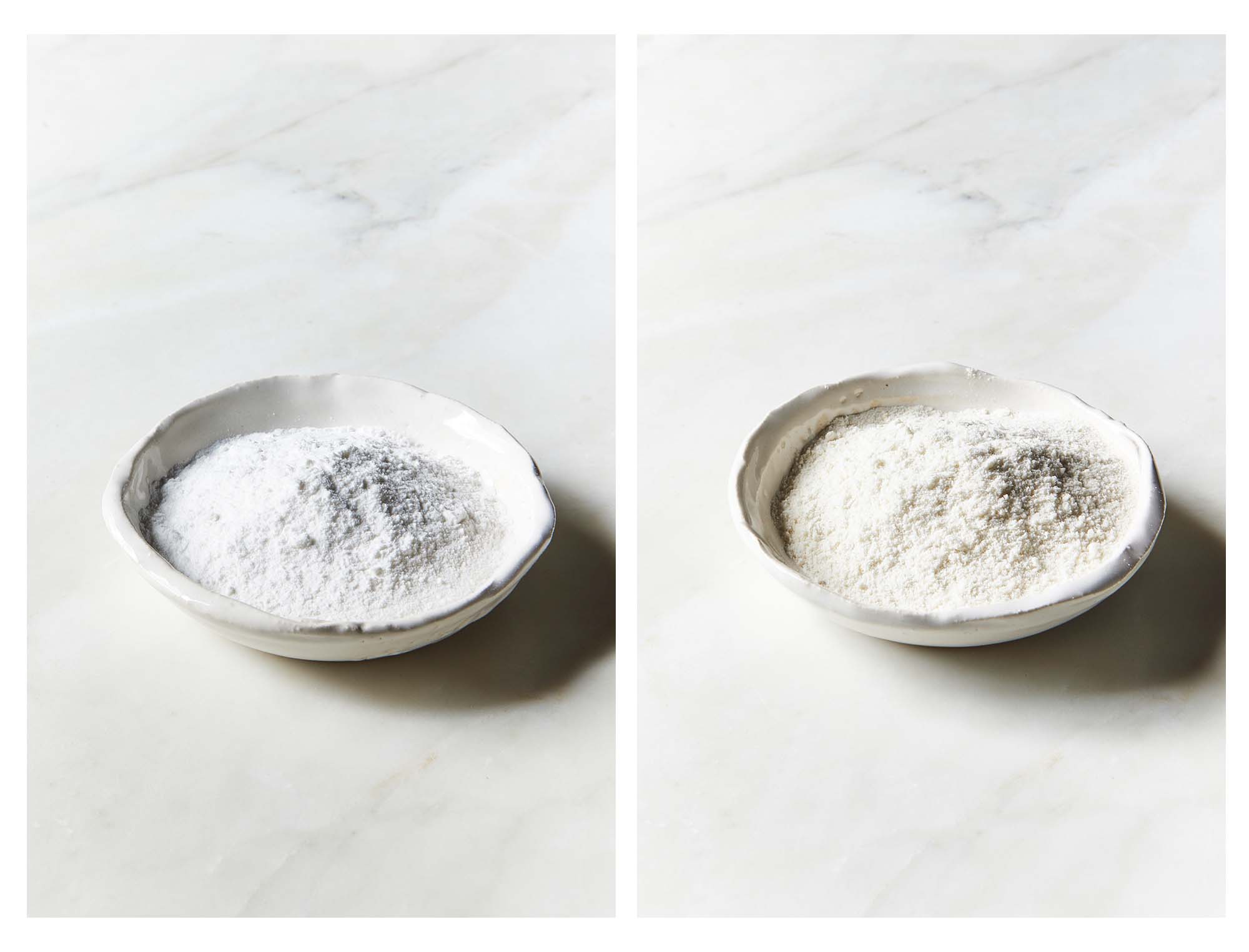
Rice Flour
Rice flour is typically sold in three varieties in the Western world:
white rice flour
brown rice flour
sweet rice flour
White rice flour is made by grinding hulled or refined polished rice kernels, and just like the grain, has a mild, bland flavor, with some protein, but not much more nutritional value, seeing as the brand and the germ have been removed.
Rice flour is very versatile, and is the most fail-safe way to modify a conventional recipe using wheat flour.
Rice flour is fantastic for use in gluten free recipes that require a light texture, and is great for rolling out dough and for making gluten-free batters, dumplings, and noodles. Rice flour is one of the most common ingredients found in most commercial all-purpose flour mixes.
I tend to combine rice flour with brown rice flour to give allergy-free baked goods a little more weight, depth, and flavor. When substituting rice flours for wheat flour in conventional recipes, rice flour is more absorbent. You might need to add a little more moisture or liquid ingredients in order to more closely replicate the consistency of the original recipe.
Sweet rice flour is made from high-starch, short grain rice, and has traditionally been used in Asian desserts. This variety is excellent to bake with, but will still benefit from the support of some other gluten free flours, and the addition of a binding agent such as xanthan. Rice flour is also great thickening agent for sauces.
Brown rice flour, like the grain, is ground from unhulled or unpolished rice. As a result, it is heavier, with a grainier texture, and a darker, brownish color. Because some of the rice bran is retained, it has more nutrients and essential oils than its white counterpart, and a lot more fiber.
Brown rice flour has a light nutty flavor that is not always appropriate in large amounts. If you use brown rice on its own, it can make the texture a bit too heavy and gritty. I tend to mix equal parts of brown and white rice flours in baking mixes, and that tends to strike a nice balance.
For those of you who are celiac please note that some rice flour is processed in facilities that also handle wheat. So look for the gluten free accreditation.
Even though rice flour is not as nutrient-dense as some other gluten- free flours I still use it for several reasons: rice flour is tolerated by most people with food allergies, it is relatively inexpensive and widely accessible making the recipes more accessible, and is really easy to work with.
Oat Flour
Made from ground whole oats, oat flour retains the nutrient density of oats resulting in a flour that is full of fiber.
If you're a celiac or have a serious sensitivity or allergy to gluten purchase oat flour that has the gluten-free accreditation due to the high risk of cross contamination.
Oat flour is not particularly impressive on its own. It can be difficult to bind and rise, and baked foods tend to become a crumbly mess.
But in combination with other flours, it works up a treat; and is fantastic at bringing a moist, chewy, slightly crunchy texture to baked goods. Mix oat flour into your wet ingredients gently, so as not to overwork the flour and destroy the carbon dioxide and oxygen; and place your batter in the oven as quickly as possible to get the most rise.
Oats contain a natural preservative, and can increase the shelf life of gluten free breads, not to mention adding a lovely rich nutty flavor and satisfying density.
Oats are subject to rancidity, due to their dense nutritional profile. So always purchase oats and oat flour from a health food store with a high turn over, store in the fridge in a sealed glass container, and use in good time. Oat flour freezes quite well; which is good way of preserving it.
Make your own oat flour by grinding oats in your food processor, mill attachment of your stand mixer; or in the dry carriage of your high-speed blender.
Millet Flour
Traditionally used in India to make flat breads, millet flour is a fantastic, nutrient-dense flour that is fantastic for enriching baked goods.
Millet flour is loaded with iron, magnesium, potassium and Vitamin B. It is a high protein, fibre-rich flour that adds a light delicate quality to baked treats, and produces a beautiful crust on gluten free breads.
Millet flour works better in combination with starchy flours such as rice, potato, or corn flour; or other protein-rich flours such as soy flour. Millet flour also requires a binding agent like xanthan, or gluten free breads tend to be too dry and crumbly.
Millet flour has a slightly sweet taste, which is similar to sorghum flour without the bitter after taste. This flour does not have a long shelf life due to its nutritional density. It becomes rancid very quickly; and needs to be stored in the fridge in a sealed glass jar. For the freshest flour, grind whole raw millet.
For those of you with thyroid disorders such as hypothyriodism, please be aware that millet flour has been shown to have an impact on healthy thyroid activity and should be eaten in moderation or avoided.
Quinoa Flour
Quinoa flour is a nutrient-dense gluten free-flour that is phenomenal for enriching baked goods.
It comes in two varieties -- milled (course) and unmilled (fine).
Both yield a flour that is smooth and creamy yellow in color, but the latter is obviously more nutritious.
Quinoa flour, like the grain, is full of fiber and loaded with protein (about 17%). It is not really great used on its own, as it tends to yield a product that is heavy and gluggy, with a bitter after taste.
The flavor of quinoa flour is actually quite mild and slightly nutty. But you will yield the best results with your gluten free baking if you combine with other flours such as sorghum, tapioca and potato starch to make nutritious baked goods, crackers, and tortillas.
Those of you with celiac disease or serious gluten sensitivities, will need to look for quinoa flour that has the gluten free accreditation as quinoa flour is sometimes processed in facilities that handle wheat and can be subject to cross contamination.
Quinoa flour has a high fat content and is subject to rancidity, so should always be stored in a glass container in the fridge and used within about 3 months.
Purchase quinoa flour from a retailer with a high turnover that stores their flour in the fridge.
Amaranth Flour
This gluten-free flour is a nutrient-dense brownish flour with a mild sweet nutty flavor that is malt-like. It yields the best results when mixed with other flours. It is nutrient rich, with three times more fiber, and fives times more iron than wheat flour. It also contains calcium, potassium, phosphorus, and vitamins A and C; and adds a lovely grainy texture to baked goods.
Amaranth flour is rich in iron and high in protein; and is a fibrous flour with a slightly sticky texture. Don’t use a straight 1:1 substitution, as your final product will be bland, and as hard as a rock! As a general rule – one part amaranth flour, and 3 parts other flours has worked well for me. Amaranth works well if combined with rice flour, arrowroot, tapioca flour, quinoa flour, oat flour, corn flour, potato starch and soy flour.
Amaranth flour works well in baked recipes that utilize strong flavors like chocolate, nuts, coconut and spices. It also makes a beautiful gluten free pancake batter when mixed with tapioca, arrowroot and almond flour; and is great for gluten free flatbreads when mixed with arrowroot.
As with all gluten-free flours, if you want to get a rise out this flour, you will need to add ½ tsp baking soda for every cup of amaranth flour and ½ tsp Celtic sea salt.
Depending on the recipe, you could also add in a little xanthan and gluten-free baking powder. Amaranth flour has a nutritional density that requires it to be stored in a sealed glass container in the fridge.
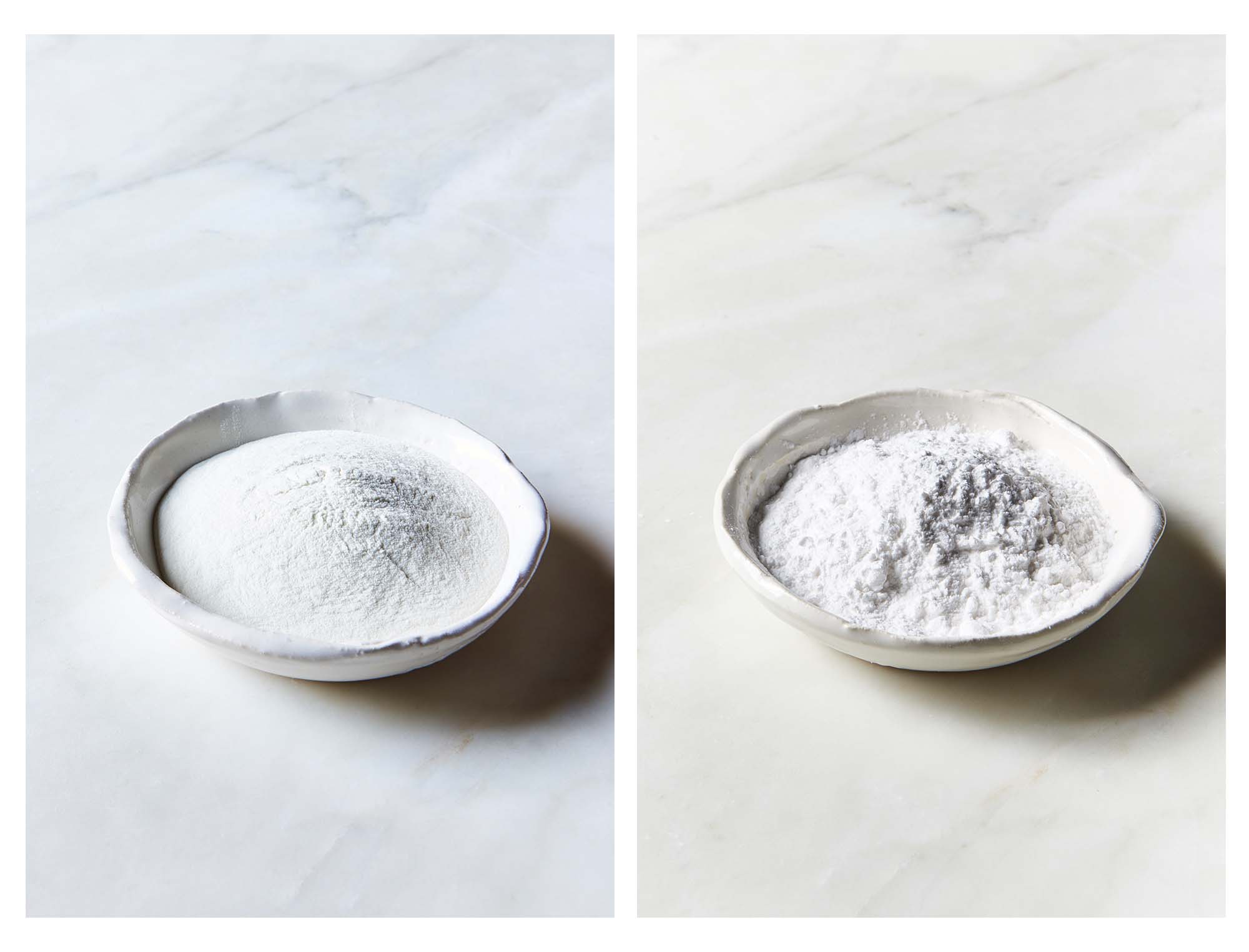
Tapioca Flour
Made from the dried and powdered root of the cassava or other species native to the Amazon, tapioca flour is one of the most versatile gluten free flours that is perfect for thickening puddings, pie fillings, and baked goods instead of arrowroot. Tapioca flour and arrowroot are often labelled as the same thing.
Tapioca flour has a light, soft white texture similar to cornflour, that helps to bind baked goods and give them a chewy texture; but really needs to be combined with other flours such as potato starch and rice flour in order to yield results that most closely resemble traditional wheat-based baked goods.
Tapioca flour is one of the most common ingredients found in most commercial gluten free flour mixes, and is fantastic for use in gluten free baked goods.
I will use it a lot and add it to gluten-free pancake mixes to make the pancakes lighter.
Arrowroot
This amazing gluten-free starch thickener made from the root stalks of this tropical plant. Look for 100% pure arrowroot, not the kind that has been mixed with potato starch.
Arrowroot is sold in sealed tins or packages, and is a light white powder that looks and feels like cornstarch. But arrowroot has no odor until it is cooked.
What makes this my gluten free thickener of choice, (as opposed to cornflour, potato starch or kuzu) is the neutral flavor that makes it great for use in mild-flavored, heat-sensitive liquids.
It is incredibly versatile, and can be used at low temperatures, and can withstand acidic liquids and long cooking times. It is really easily digested and doesn’t have that chalky taste that is so common with cornstarch. Another added benefit over cornstarch, is that sauces thickened with arrowroot freeze really well. I use it to thicken sauces and pie fillings.
To use it -- just mix the desired amount of arrowroot in an equal amount of filtered water. Generally, 1 to 1 1/2 tablespoons of arrowroot will thicken 1 cup of liquid. Obviously, you can add more or less, depending on the desired thickness. For those of you with an allergy to corn starch, arrowroot is a blessing. To substitute, use 2 teaspoons of arrowroot for every 3 teaspoons of corn starch. Whisk into the liquid at the end of the cooking process and stir to get the desired consistency. It doesn’t take very long. The liquid will continue to thicken a little once removed from the heat. Be careful not to add the arrowroot in too early, as overheating can destroy the thickening agents.
If substituting arrowroot for flour in recipes, only use half the quantity. Arrowroot is fantastic for making homemade jello and puddings. Just boil 1 tablespoon of arrowroot to every cup of fruit juice and add in fruit pieces. Sweeten, and then chill and set in cups. Store arrowroot in the fridge, and use within a couple of month, or the thickening properties will be compromised. Arrowroot can also be used in gluten free flour mixes to help lighten the texture of baked goods.
Kuzu
With a white chalky consistency, kuzu is a fantastic thickening agent similar to arrowroot when mixed with a little bit of water.
Kuzu is also loaded with minerals and protein to enrich dishes, and has a wide variety of uses as a powerful medicinal herb.
Kuzu is a vine-like leafy legume plant native to Japan and China. It was introduced to the Southern United States in the 1870’s and used to prevent soil erosion, but grew so prolifically, that after being classified as a weed in the 1950’s, has been dubbed “the vine that ate the South”. Kuzu is now causing problems for crops in the north of Australia.
But onto the magical benefits of kuzu. It is a little bit more expensive than other gluten free thickeners. But the medicinal benefits make it an invaluable part of my diet. Kuzu has been widely used as a medicinal plant in Asia to treat the effects of alcoholism, anxiety, depression, hypertension, high blood pressure, heart disease, diabetes, asthma, arthritis, diarrhoea, chronic headaches, menopause, and the list goes on and on! It contains powerful isoflavones such as daidzein, which has anti-microbial and anti-inflammatory properties; genestien, which helps to stabilize hormone levels; and puerarin, which purports to have 100 times more antioxidant power than Vitamin E.
Kuzu root has also been known to stabilize seratonin, dopamine and GABA levels in the brain, normalizing these neurotransmitters for use with depression. Kuzu root tea also lowers blood pressure and blood sugar levels, and has been used in Asia for centuries to suppress alcohol cravings and repair alcohol damage to organs.
Kuzu is also incredibly alkalizing due to its high mineral content. I use kuzu root tea as a great elixir to counterbalance an extremely acidic meal and restore my alkalinity. It also has powerful anti-aging benefits. For those concerned with osteoporosis, kuzu also has positive effects on cell reproduction critical for bone density and new bone growth; and is great for increasing circulation, which relieves muscle pain and stiffness. This edible starchy powdered root really is a superfood, and I can’t rave enough about it.
Like all foods, consult a physician before embarking on a kuzu root binge in the hopes of curing any and every ailment. I am suggesting it mainly as a gluten free thickening agent. But I couldn’t resist the opportunity to share all of the other incredible benefits.
Dried kuzu can be found as a herbal supplement at health food stores in tablet and liquid form; and powdered kuzu root for use in cooking can be found at Asian grocers and health food stores. I drink it as a tea and use it to enrich and thicken fruit sauces and mixtures for pies, puddings, and cobblers; as well as soups, stews and gravy.
Kuzu root is sold in bags and looks like cube-sized chunks. You just crush the little chunks into a powder in a spice grinder and use about 3 tablespoons of powder to thicken every 2 cups of liquid. Just like cornstarch or arrowroot, mix it with equal parts of cold water to make a paste before adding to the liquid that needs to be thickened. It usually only takes a few minutes to simmer and thicken.
My favorite way to use kuzu root is to make gomadofu - sesame tofu. My all-time favorite food. The recipe is in my book.
Potato Flour and Starch
Potato flour
This gluten-free flour is made by grinding whole potato flakes made from whole cooked, mashed potatoes that have been dried in a special drum. Potato flour contains some of the fibers of the whole potato, and is slightly heavier than potato starch, with a brownish tint and a slight potato flavor.
Potato flour is a fantastic gluten free binding agent that brings a density and moistness to baked goods when combined with other gluten-free flours such as rice and soy flour.
Potato flour is traditionally used in Jewish goods made during Passover, when grains are not eaten.
Always store potato flour in a sealed glass container in the fridge away from any moisture; and use within 6 months.
Potato Starch
Potato starch is made from grinding potato tubers that have been washed to remove the fiber and protein to separate the starch, and then refined again. Potato starch is a stark white powder that looks similar to cornstarch. It has a neutral smell and taste, and is great for use as a gluten free thickening agent.
Potato starch has little nutritional value, but it makes a fantastic addition to gluten free flour mixes and is one of the most common ingredients found in most commercial all-purpose baking mixes.
Corn Flour and Starch
There are two main types of cornflour -- white cornflour (corn starch or maize starch) and yellow cornflour (fine cornmeal). Both are fantastically useful for gluten free cooking, and are inexpensive and widely available.
Note the origin of the recipe in order to determine which cornflour is appropriate. For example, in the UK, Australia and New Zealand, the terms cornflour and cornstarch are used interchangeably. Similarly, yellow cornflour is referred to as polenta.
White cornflour or corn starch, is the white powdery starch of the corn (maize) which is milled from the endosperm part of the corn kernel. This starch is widely used as a thickening agent. But it does not work very well with prolonged heating or extremely acidic conditions.
To use, just dissolve the required amount in double the amount of cold liquid, and then add to any warm liquid to be thickened. The liquid will turn a whitish color initially, but just bring to the boil and keep stirring, and it will blend in.
I don’t like the chalky flavor of white cornflour and prefer to use the more neutral arrowroot as a thickener. But I find it incredibly useful as a binding and releasing agent when combined with other more fibrous flours in doughs and baked goods.
I also love to use it to make batters in Japanese dishes like agedashi tofu and tempura. Just note that anything thickened with cornstarch will not withstand freezing. When defrosted, things turn into a spongy mess.
Yellow Cornflour or Cornmeal (Polenta)
Yellow cornmeal is either the steel or stone ground meal of dried corn. It is ground to fine, medium and course consistencies.
All can be used for gluten free baking, depending on the needs of the recipe. I tend to mainly use fine and course varieties in most blends; and I prefer the stone ground variety (which has a little bit more flavor and contains some of the hull and germ making it a more nutritious) for enriching recipes and eating as a grain for main meals. This variety is best stored in the fridge in a sealed glass jar.
Yellow cornmeal is used widely in a lot of different cuisines to coat, crumb and top; as well as being the key ingredient in cornbread and tortillas. I find it adds a fantastic gritty texture that adds a sustaining bite to savory baked goods. I don’t tend to use blue and white cornmeal.
White cornmeal is more commonly used in African cuisine, and I have never used blue corn. I love baked blue corn chips. But that is far as I have ventured.
Cornmeal has anti-fungal properties; and soaking your feet in a cornmeal mixture can help get rid of athlete’s foot. Horticultural cornmeal is also used as an anti-fungal fertilizer.
Baby Rice Cereal
This traditional introductory food for babies is made from finely milled, cooked and dried rice flakes that are very easily digested. But it is not just for babies. It is a wonderful gentle food for post-operative patients or people with intestinal disorders.
It is also a really versatile ingredient that can be used effectively to make veggie burgers; help lighten the texture of gluten free breads, and bring a nice crisp finish to cookies, biscuits and pastries.
Baby rice cereal works really well as a substitute for almond meal or coconut flour for people trying to reduce the caloric profile of baked treats. But for those of you watching your blood sugar levels, please note that baby rice cereal is high on the glycemic index.
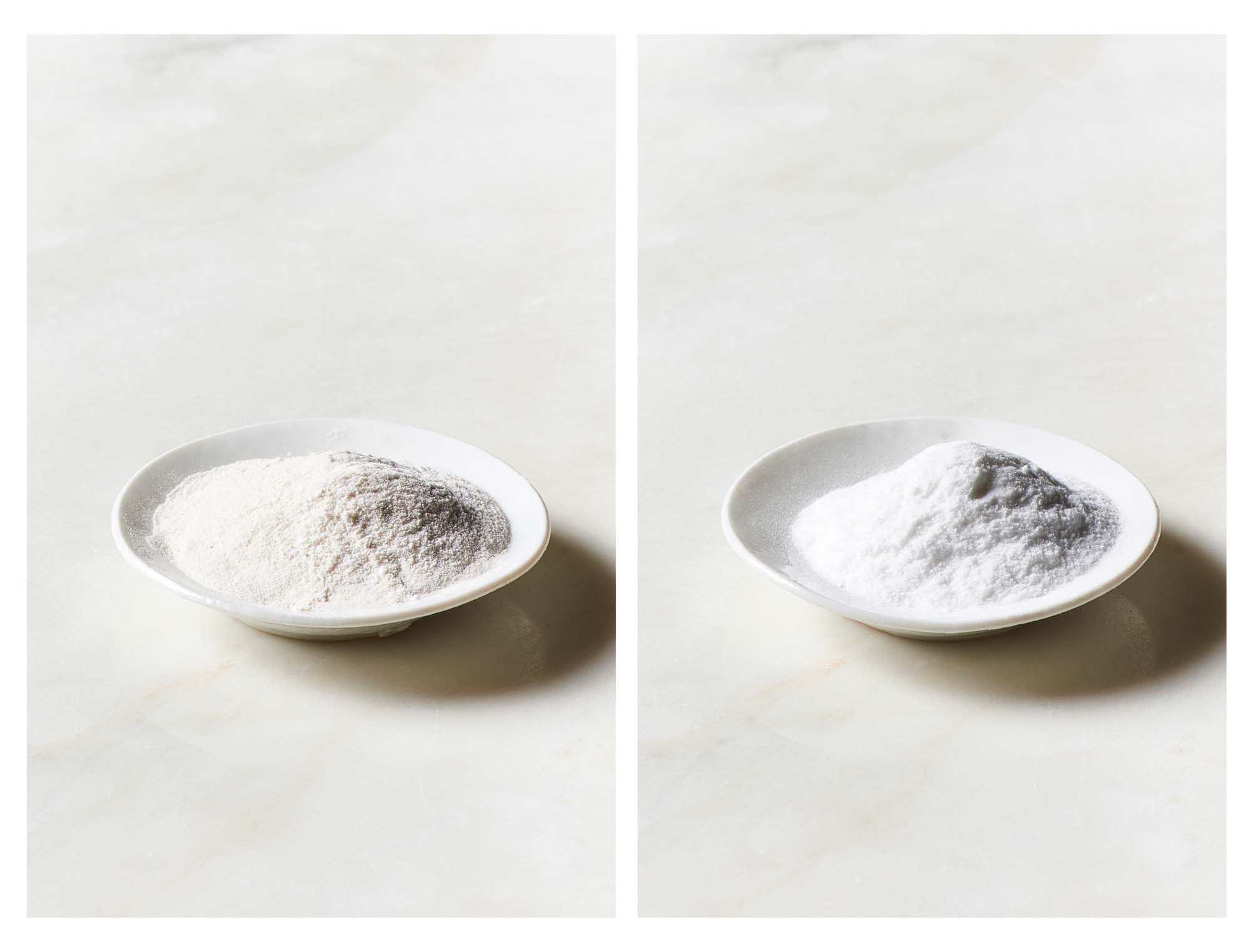
Baking Powder
This leavening agent that is so important with traditional baking is a lifesaver when working with gluten-free flours.
Baking powder is a mixture of sodium bicarbonate, an acidifying agent (cream of tartar), and a moisture absorption or drying agent, (a starch). Some baking powders use wheat starch, so be sure too look for brands that use corn starch or potato starch.
Any baking powder made with potato or cornstarch is fine; and these are always clearly labelled as gluten free. But be careful of any that may contain wheat starch. There are a lot of gluten free baking powders available. But I always purchase brands that are aluminum-free.
You will also see baking powder labelled as “single-acting” or “double acting”.
Single acting baking powder is activated by moisture and reacts as soon as you mix it in. So place your gluten free baked goods in the oven immediately to achieve the best rise.
Double-acting baking powders react in two phases with moisture and heat; and are great for use in gluten free doughs that begin expanding at room temperature, and then continue rising in the oven.
Most baking powders are double-acting these days, making them easier to work with. It just means you can wait a little while (about 20 minutes) before baking and you won’t lose your leavening magic! In order to get the most out of this “double rise” effect with gluten free flours it is really helpful if all of the ingredients are at room temperature.
Just with traditional baking, not all recipes require baking powder. I often just use baking soda for baked goods like gluten free cookies and flat breads. But I will more often than not, include a teaspoon of gluten free baking powder along with 1/2 teaspoon of baking soda for every cup of gluten free flour used in recipes where I need to get a good rise. 1/2 teaspoon or 1 teaspoon of xanthan and a pinch of Celtic sea salt, and you have a blend that is a good start for most cakes and muffins.
Obviously, the quantity of baking powder will vary depending on the other ingredients in the recipe. Baking powder has a neutral flavor when added in the right quantities. However, you get a bitter taste if you add in too much.
Too much baking powder can also cause batters to rise too rapidly (the air bubbles expand too much and then collapse), resulting in gluten free cakes that sink in the centre and crumble. Too little baking powder results in a dense cake that lacks spring.
The other thing to take into account is the addition of acids. Acids heighten the power of baking powder. For recipes containing a lot of lemon juice, for example, you can decrease the amount of baking powder by half.
Always sift your baking powder with your flours and mix thoroughly to ensure uniformity throughout your batter to avoid holes in your final product.
Store baking powder in a cool dark place in the pantry and replace every 6-12 months.
To make your own home made baking powder: mix ¼ teaspoon of baking soda with 1/2 teaspoon of cream of tartar. This is equivalent to 1 teaspoon of commercial baking powder and is helpful if you run out!
Baking Soda
Also known as bi-carb soda, this is pure sodium bicarbonate and is typically used as a leavening agent in baked goods. This means that when combined with an acid (such as lemon juice, vinegar, cocoa, molasses, maple syrup) and a liquid, it produces carbon dioxide that expands in the oven causing baked goods to rise.
It is invaluable for gluten free baking. When baking flat breads and crusts you might only need to use baking soda. But if you are making cakes and breads you will usually need to add in some baking powder as well.
I typically add in ½ teaspoon of baking soda to every cup of gluten free flour. But obviously, this is only a guide, and quantities will be dependent on the other ingredients, and how much acid and moisture is in the recipe.
Baking soda has a bitter taste if not counteracted by the right amount of acid and liquid, so if you add too much it will have an unpalatable effect on your final product.
Also make sure you sift the baking soda with the flours, and mix through thoroughly to avoid holes in your final product. Baking soda starts reacting as soon as it is mixed into the acid and liquid, so bake immediately after mixing to achieve the best results.
Baking soda is also a powerful alkalizing agent and helps neutralize acids and break down proteins. It is also really helpful to soften and tenderize foods making them easier to work with.
I will often soak dates and other fruits in a bit of water and baking soda to soften them before adding them to recipes. I will also add a pinch to homemade sauces and soups to help reduce the acidity while cooking.
A pinch of baking soda added into legumes helps to soften them and reduce the gas effect!
I add a pinch of baking soda and Celtic sea salt to my filtered water when I drink it to help alkalize my body throughout the day. I also use it mixed with filtered water in place of conventional toothpaste to brush my teeth.
Baking soda can be used all over the household. I mix up a paste with water to clean my kitchen. It is a gentle abrasive that is gentle enough for most surfaces, and makes an inexpensive green alternative to conventional toxic cleaners. I also add it into my laundry load to alkalize the water and boost the power of the detergent.
Cream of Tartar
Cream of tartar is the common name for potassium hydrogen tartrate which is an acidic salt commonly used to improve the quality of baked goods.
This fine white powder is ground from the tartaric acid sediment that is removed and purified from inside the lining of wine barrels after the fermentation process of grapes in wine making.
Cream of tartar is the acidifying agent commonly used in baking powder, and is invaluable in gluten free baking for enhancing the rise effect with gluten free flours.
If you don’t have any baking powder on hand, you can make your own by adding ½ teaspoon of cream of tartar to ¼ teaspoon baking powder, which is the equivalent of 1 teaspoon of commercial baking powder.
Cream of tartar also helps to stabilize and increase the volume of beaten egg whites. You typically add in about 1/8 teaspoon for every egg white. White vinegar also works really well for this.
Cream of tartar is also a helpful homemade household cleaner if mixed into a paste. It is fantastic for removing rust stains!
Cream of tartar should be stored in a cool dark place in the pantry or fridge and will keep for years.
Xanthan Gum
Pronounced "zan-theen" this gum is made by fermenting corn sugar with a bacteria (xanthomonas campestris), and is a common natural food additive (#415) used as a stabilizer and thickening agent in ice creams and other dairy products, in salad dressings and desserts, and in many gluten-free recipes and products.
I used it years ago, and you will find it in many of the earlier baked recipes on the site.
Xanthan gum is the easiest way to replicate the structural function of gluten, helping to give structure, texture, rise, and kneadability to gluten free-batters and doughs.
However, it is not always necessary to use xanthan in gluten free baking. When using nuts flours like almond, hazelnut, chestnut and coconut, finished products can hold together beautifully with eggs and egg substitutes.
When combining other flours such as potato, corn, tapioca, millet, buckwheat, quinoa, oat, rice, sorghum and garbanzo bean; xanthan is usually a welcome addition.
Generally, add about ½ teaspoon of xanthan for every cup of flour. I will add 1 whole teaspoon for every cup of flour if I require a bit more elasticity for pastries and doughs; and will sometimes add up to a tablespoon for more traditional bread that requires a high-rise dough with a lot of elasticity.
With xanthan gum, a little goes a long way. You can feel how sticky it is when you touch it with your fingers. It feels like a gum to the touch. Use too much and you will end up with a gooey mess that tastes like rubber.
More research has been done on xanthan gum, and many people are removing it from their recipes and products as the demand for gum-free products increases.
Xanthan gum is derived from the bacterium Xanthomonas campestris, the pathogen responsible for the black rot that devours broccoli, cauliflower and other leafy vegetables. In order to grow large quantities of xanthan gum it is harvested in batches that are grown through the fermentation of yeast and sugar. Most batches are fed high fructose corn syrup, but others are fed wheat, soy, or dairy.
A 2011 study by Jennifer Beal with the Center for Applied Nutrition, concluded that premature babies that ingested test tube nutrition containing xanthan gum immediately developed necrotizing entercolitis, or intestinal tissue death. Premature infants have exceptionally delicate immune systems, making them far more susceptible to bacterium and toxins, and xanthan gum was no exception.
For those people with celiac disease, who have delicate intestinal tracts xanthan gum could be a danger.
I will let you decide if xanthan gum is a responsible choice for you and your family.
I am not using it anymore.
Guar Gum
Like xanthan, guar gum helps to replicate the structural function of gluten.
Guar gum is natural, and is derived from the endosperm of the guar plant.
Prized for centuries for it’s healing properties such as lowering cholesterol, more recent studies have shown guar gum to be helpful in maintaining healthy blood sugar levels.
The jury is still out as to whether guar gum is a health-promoting food.
Many people and brands are moving away from using gums in recipes and commercial products.
The clear downside: guar gum can have a laxative effect on some people. So test it out before using it too much.
Yeast
Yeast is a living organism that is part of the fungus family.
Baker’s yeast comes in two varieties -- fresh and dry, and like baking soda and baking powder, acts as a leavening agent in baked goods. The yeast feeds on the sugar in the dough to produce carbon dioxide which expands and gives rise to doughs and batters. It also improves the texture and flavor of baked goods and is helpful but not always necessary when baking gluten-free bread.
I don’t use yeast very often in my baking. But when I do, I always use dried yeast.
Dried yeast is fresh yeast that has been pressed and dried to reduce the moisture content, rendering the yeast dormant until it is mixed with a warm liquid.
You can find dried yeast in “active” and “rapid-rise” yeast, which is also known as “instant” or “bread machine” yeast. Instant yeast is finer and works a lot quicker than active dried yeast. But has less flavor. I find that active dried yeast is the most effective and easiest when working with gluten free flours.
Purchase active dried yeast in sealed tins or small vacuum-sealed foil sachets. I like to purchase the sachets to increase the shelf life and freshness. The small 7 gram / ¼ ounce / 2 ½ tsp packets can be opened as needed. The minute you expose yeast to air, it begins to deteriorate. This is why a lot of recipes call for the yeast to be mixed with a warm liquid and sugar (called proofing) in order to ensure the yeast is active before adding it to the whole dough mixture. You are looking for foaming and bubbles. If you don’t get any -- your yeast is dead. Grab another sachet!
If you check the use-by date on your sachets this proofing really isn’t necessary, and you can just add the dried yeast granules into the flour mixture and then add the liquid. It is up to you how cautious you want to be.
If you purchase dried yeast in a tin, make sure you store in a sealed container in the fridge away from moisture, heat and light. Please make sure the yeast is gluten free. Most brands available are gluten free, but some brands are made with wheat flour.





